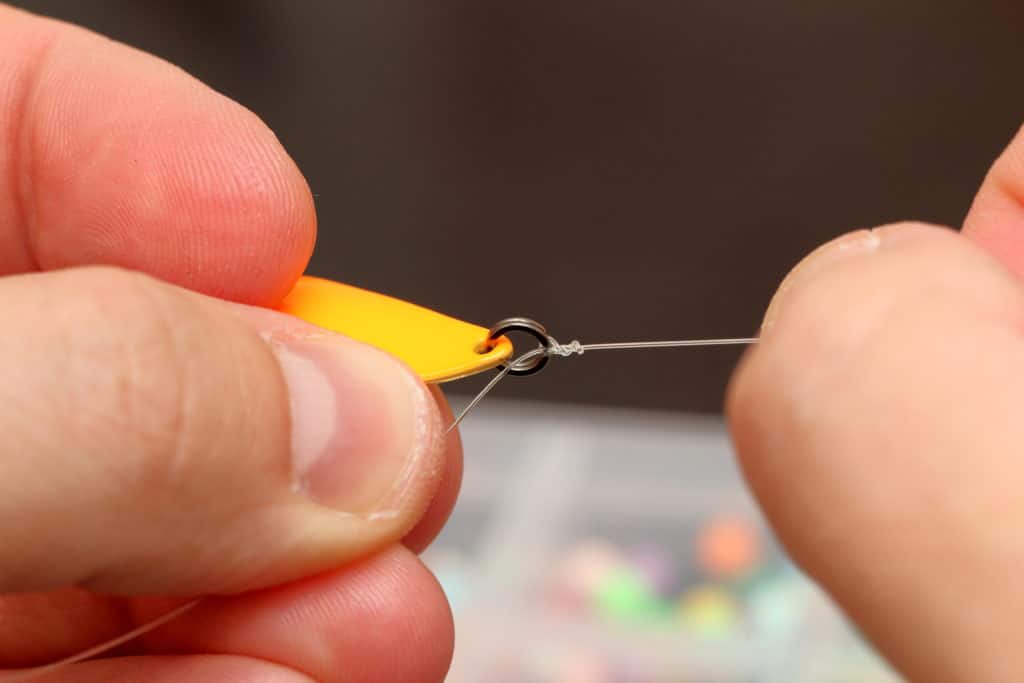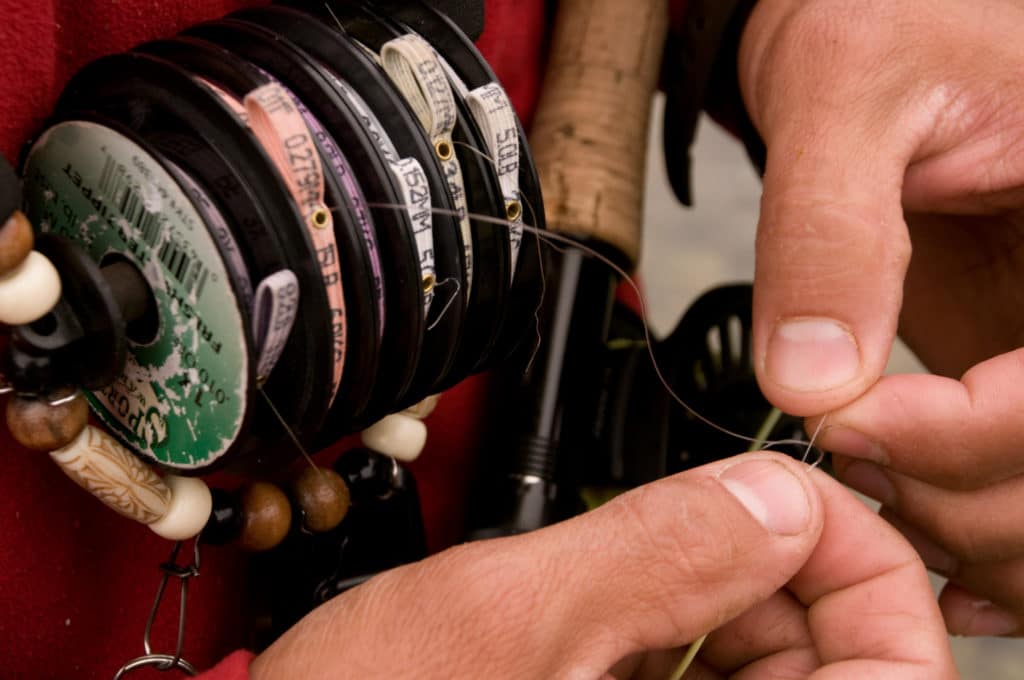The strongest among all fishing knots is the Palomar Knot.
The Palomar Knot is somewhat simple yet very effective.
It’s best used with a braided fishing line, and it’s so simple to tie that you can do it in the dark with a little practice.
It’s considered one of the most durable and dependable fishing knots. Both beginners and veterans use the Palomar knot.
A key angling skill is to tie a few strong, dependable fishing knots.
Knots are utilized to secure lines to lures, hooks, and reel spools and connect two lines.
It’s bad news when a knot slips or comes undone, as it might result in the loss of the lure and a fish.
While there isn’t a one-knot-fits-all solution, the Palomar Knot is a good starting place because it’s easy to tie and is multifunctional.

Contents
What Is A Fishing Knot?
A fishing knot is an overhand knot that links two lines by fastening one end to the opposing standing segment.
It can be easily described as a knot for uniting two ropes of identical thickness.
Each rope wraps an overhand or a double overhand knot around the other, causing the two knots to jam together when pulled tight.
The skill to construct an efficient knot is necessary for all parts of fishing, from attaching the fly to your fishing line to tying your line to the backing. Learning how to tie different knots might be overwhelming.
It requires a lot of mental energy to keep track of the names.
While tying a knot that holds under strain may be straightforward, different knots are utilized for different purposes.
The way the knot sits against the line and its bulkiness might differ between scaring away a fish and luring one in.

Why Is A Strong Fishing Knot Important?
To securely tie the fishing line to the lure, hook, or other tackle, a sturdy fishing knot is required and you must be able to tie the type of knot that will reliably bring in the fish.
There are a few steps to ensure that your fishing knot is strong enough to do what you are planning to use it to achieve.
- For appropriate knot tying, leave about 1 foot of fishing line on the tag end.
- Before tightening the knot, wet it with saliva. This will permit you to pull it tighter and protect the line from harm.
- Remove the extra line. Many anglers are inclined to leave a large amount of additional line just in case a knot slides out a bit. It shouldn’t slip if you’ve done everything correctly and tied it tight enough. And that extra line is begging to get tangled up in rocks and weeds.
- It’s all about practice, practice, practice! You can retie the knots with a dulled hook or a cork over the sharp end until it is natural and easy.
Types Of Fishing Knots
There are so many fishing knots you probably won’t even be able to recall all of them after a while.
This section will list and explain how to tie some of the most important types of fishing knots.
Improved Clinch Knot
Use the improved clinch fishing knot to connect the line to a hook or lure.
When tying a fly, swivel, or hook to your leader line, this particular fishing knot is simple and it is a dependable terminal knot to tie.
Because it’s particularly fit for lines up to the 20-pound test, many anglers prefer to use this knot while engaging in light tackle fishing or when embarking on freshwater fly fishing.
How To Tie The Knot
This “enhanced” Clinch Knot is so widespread that most anglers have forgotten about the traditional Clinch Knot.
This is how to tie the knot:
- Pass the end of the line through the eye of the hook. Make five or more loops around the standing line, then double back.
- Return the end of the line to the initial loop produced behind the eye and then to the big loop.
- To tighten the coils, wet the knot and pull the tag end. Close the tag end by sliding it firmly against the eye.
Blood Knot
A Blood Knot is difficult to master, yet it’s necessary to join the fly line to the backing, link the lead to the tippet, or mix sizes.
While the Blood Knot is two enhanced clinch knots joined together, it takes time and practice to master.
Trilene Knot
The Trilene Fishing Knot is useful for tying line to lures, snaps, hooks, and swivels and is best used with monofilament or fluorocarbon leaders.
The Two-Turn Clinch Knot is a variation of the Trilene Knot.
The Trilene Knot is strong, although not as acclaimed as the famed Palomar Knot.
How To Tie It
- Slide your fishing line in the hook eye, then repeat it, entering the line in the same direction and making sure the hook eye forms a double loop.
- Wrap the tag end four or five times around the standing line, drifting away from the hook.
- Return the tag end to the double loop at the hook’s eye, wet the knot, draw it snug against the hook eye, and cut the tag.
Snell Knot
A Snell Knot is a knot used to attach a monofilament leader or a fly-fishing tippet to a hook or from the leader to the tippet.
Due to the obvious way it equalizes friction, this terminal fishing knot is frequently regarded as one of the strongest.
Although the Snell Knot was created to be used with eyeless hooks, it is still commonly used today.
It’s a popular knot among saltwater anglers who utilize live bait, freshwater bass anglers who flip and pitch Texas rigs into tangled vegetation, and fishermen who fly fish with a tube fly use it to keep the hook straight.
Using this type of fishing knot has many advantages.
First, you can tie knots with monofilament, fluorocarbon, or braid lines.
Second, getting a proper hook set is stronger and quicker because this knot is aligned with the hook’s shank.
Third, this type of fishing knot is not easily loosened or dislodged.
Uni Knot
A Uni Knot is a popular choice among the many fishing knots.
This is because the knot is relatively quick and simple to tie.
This knot is comparable to the Fisherman’s Knot in strength and difficulty.
This knot works well with both braided lines and monofilament lines.
Bobbin Knot
A Bobbin Knot seems to be the only fishing knot guaranteed to stand up 100% of the time, assuming you tie it properly.
It’s a dream come true for offshore anglers, and it’ll hold up against even the biggest fish.
To be sure, this isn’t the most straightforward knot to tie.
To knot it properly, you’ll need practice and a bobbin tool.
The PR Bobbin Knot should also be tied the night preceding your fishing trip.
Turtle Knot
The Turtle Knot is a fishing knot that is effective for thin lines and tiny hooks connecting lines to hooks and lures.
The Turtle Knot is among the most often used fly fishing knots to secure a tippet’s small hook or fly-fishing leader.
There are hundreds of knots available to anglers, and it might be a bit of a stretch if we attempt to exhaust them in a single article.
The strongest knot is the Palomar, and we will delve a little deeper into it shortly.
Palomar Knot
When tying a line to a lure or hook, the Palomar Knot is employed.
Many anglers and their friends consider Palomar Knots the best fishing knots with light fishing lines (like braided lines) because they preserve much of the original line strength.
Advantages
- It is simple to tie
- When properly tied, it is a strong knot and does not slip
- It operates with both light and heavy lines in both fresh and saltwater
- The fishing knot can be used with monofilament, braided, and fluorocarbon lines
It works best when utilizing non-swimming lures like jigs or any other bottom-bouncing lures.
However, when connecting a weight, you should avoid using this fishing knot because it tends to drag.
Overall, this is an extremely important knot that you should learn to tie as soon as possible.
Tying The Palomar Knot
Pass about 6 inches of line through the hook eye and double it.
In the doubled line, tie a basic overhand fishing knot, leaving the hook dangle loose.
Twist the lines as little as possible. Pull the loop’s end down until it’s entirely over the hook.
To draw up the knot, moisten both ends of the rope and pull them together. Remove any excess.
Conclusion
As an angler, learning to tie a strong knot is essential.
A strong fishing knot is crucial to a successful fishing expedition.
You must pay adequate attention to it.
The Palomar Knot is easy to learn yet remains one of the strongest knots.
Hence, it would be best if you learned to tie it.







